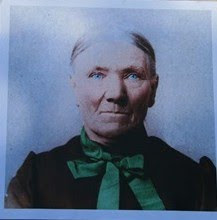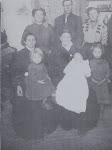 |
Viola Bell Boice Memorial
Birth: 1873 Death 1961 |
A Short Story of our Mother's Life
History 2a from Delilah Boice Asay's Book of Rememberance
Our Mother, Viola Bell Hawkins Boice, was born September 30, 1873 in Marion county, West Virginia.
Her family was converted to the church of Jesus Christ of Latter Day Saints by Elder B.H. Roberts on his first mission to Tennessee.
At the age of fifteen, after a year's courtship, she was married to Shade Boice in the Logan Temple.
While in Tennessee, she tells of picking wild blackberries, also of running races picking cotton with the Missionaries who stayed at their home a lot of the time. Her Father owned a large plantation, on which he gew cotton and tobacco and had Negro slaves.
When she was a girl in Colorado, she did a lot of skating, dancing, and horseback riding.
She was the youngest of nine children. Her Father died six months after she was married and six months later her first child was born -- a cranky spoiled little girl. They named her Viola May. Mother tells of having to keep the lamp burning for hours at a time to keep her quiet.
A year and half later her second child was born -- a brown eyed boy. Our Father was working at the time for President Heber J. Grant. Brother Grant asked them to name him Heber J. after him, which they did.
Mother was blessed with thirteen children, eleven of them are still living. She had many joys and sorrows but a loving husband that shared them with her. Besides raising their own children, they helped in the rearing of her sister's two children, and for years she did her own washing, ironing, and sewing and also washed, ironed, and sewed for these two children and her Mother.
The family always had plenty of food and clothing but when times would get a little hard, Mother would send some of her older children out with some of her beautiful crocheted work and help add to the family income in this manner. She was always a good housekeeper, cook and a good manager. She was a grandma at the age of thirty-four.
At the time our Father went on a mission for the church, there were five children in the family and they lived on the ranch most of the time while he was away, with our Uncle helping out with the farm work.
Here is a little poem called "A Perfect Day", that describes a few of the things she did.
MOther on a winter's day, milked the cows and fed them hay,
Sloped the hogs, saddled the mule, and got the children oof to school.
Did a washing, mopped the floors, washed the windows, and did some chores;
Cooked a dish of home-dried fruit, pressed our brother's Sunday suit,
swept the parlor, made the beds, baked a dozen loaves of bread,
Split some firewood, and lugged in enough to fill the kitchen bin;
Cleaned the lamps and put in oil, stewed some apples she thought would spoil;
Churned the butter, baked a cake, the exclaimed, "for heaven's sake, then calves
have got of the pen", whent out and chaed them in again;
Gathered the eggs and locked the stables, back to the house and set the table,
And afterward washed up all the dishes; fet the cat and sprinkled the clothes,
Mended a basketfull of hose, then opened the organ and began to play
"When you come to the end of a perfect day".
She lost her Mother in 1925 and shortly after that, they moved to Los Angeles, Calif. She and father took several nice trips in the last few years of his life. Charles and May took them in their car and they tur
ned the United States, Old Mexico and Canada.
They celebrated their Golden Wedding, 12 Oct 1938, in Griffeth Park, Los Angeles, with over sixty of their descendents present.
The saddest thing came into her life, when we burried our Father, Although lonely for him, she found joy and happiness in being with her children and grand children.
She will be eighty years old next Sept, 30th; has at this time had thirteen children; forty-five grand children; and sixty great grand children.
 |
Undated "History 2a"
Delilah Asay's Book of Rememberance |
 |
Rose Hills Memorial Park
Whittier, Los Angeles County, California, USA
Find A Grave # 40396762 |



























